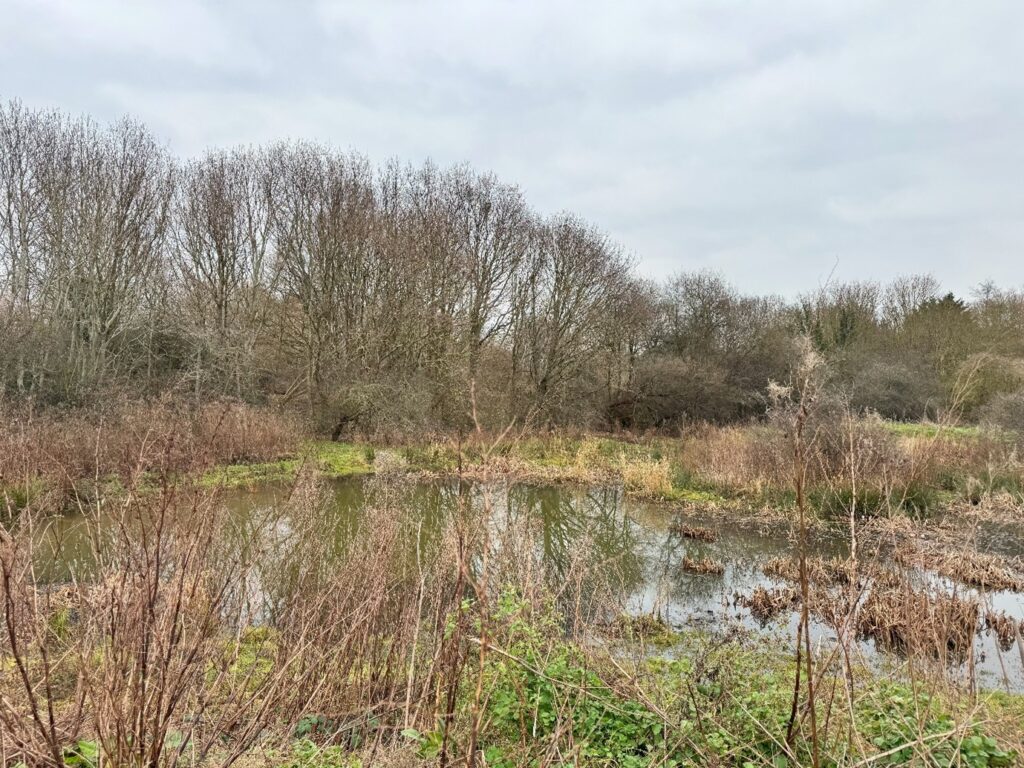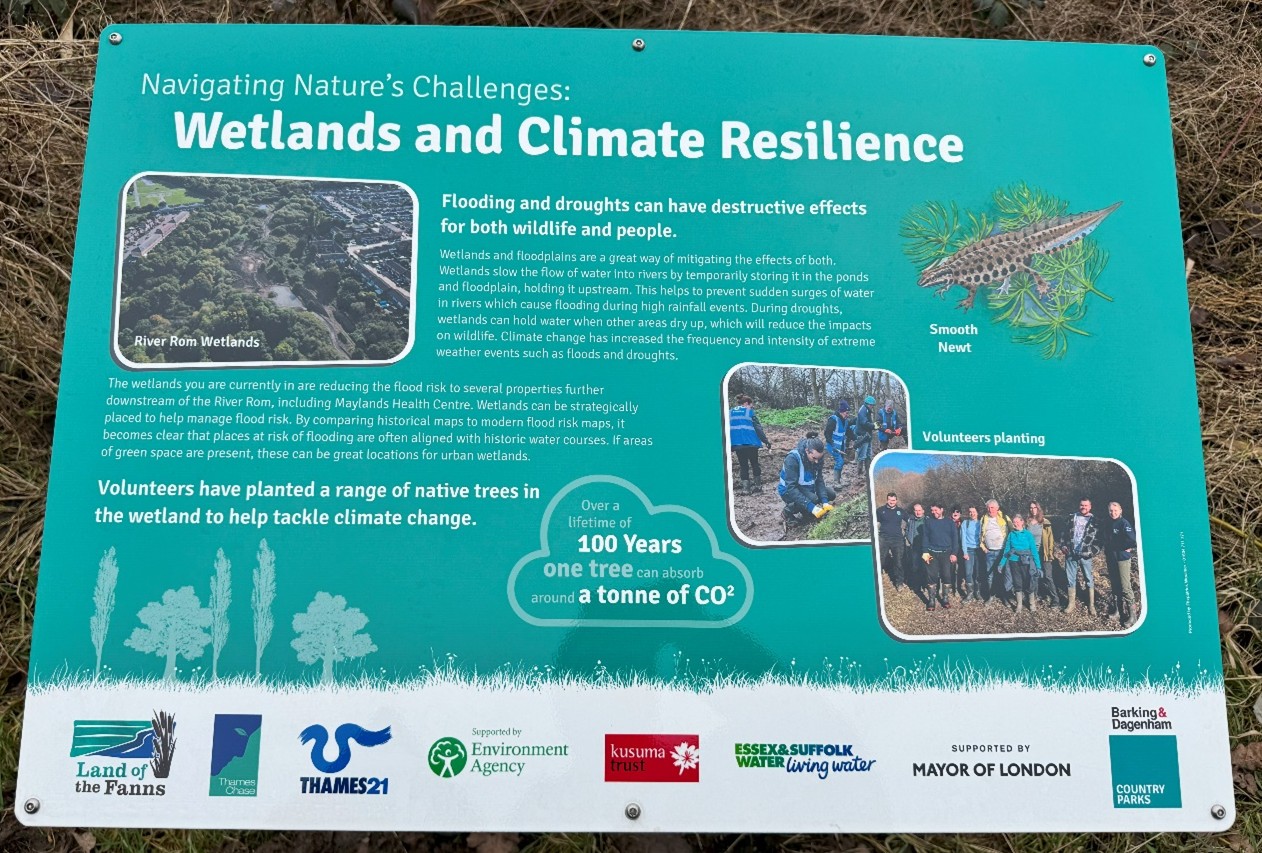Assistant Flood Risk Engineer, Will Hammond, recently visited the Chase Local Nature Reserve, Dagenham, London to participate in an educational visit looking at a reach of the River Rom – an example of river restoration in a dense urban catchment.

Background
Situated in the London borough of Dagenham and Barking, the River Rom is a flashy catchment with the section upstream of the nature reserve culverted beneath Romford until its outlet into the park. The park was once a gravel extraction site and was victim, like many urban rivers, to artificial straightening and pollution.
The main objectives behind the restoration, which aimed to undo the damage inflicted on the reach, were to reconnect the river and its floodplain to create diverse habitat and enhance biodiversity; reduce downstream flood risk by storing water during high flow events utilising natural methods; and encourage collaboration and community involvement by fostering partnerships between local stakeholders and organisations.
The project required careful coordination and planning. This was led by Thames 21, supported by Thames Chase and was developed on Barking and Dagenham Borough Council land. The project was also supported by the Roding, Beam and Ingrebourne Catchment Partnership, Environment Agency, Havering Council and Havering Wildlife Project. Funding was sourced by Essex & Suffolk Water, the Environment Agency, Thames Water, Kusuma Trust, and the Mayor’s Rewild London Fund. For the groundwork itself, local community volunteers were used as the labour force for works and as maintenance post-construction – locals were involved from the conceptual stage right through to ensuring the future of the scheme.
Technical Aspect
Within the nature reserve, multiple efforts in two stages were coordinated to bring the river and its floodplain back to a natural state. Stage 1 included designs, public consultation, flood risk activity permit applications and other consents. Stage 2 involved executing and implementing the scheme. This firstly included implementing a system of offline ponds (scrapes), creating seasonal wetland which would inundate periodically but otherwise remain dry, as well as an online pond.
Secondly, an embankment ran along the right bank of the channel, and this was breached in 3 locations to increase connectivity between the channel and the scrapes.
By temporarily storing water in the floodplain via the ponds, flow is attenuated during times of flood, reducing flood risk to vulnerable properties and infrastructure downstream.

Figure 1: Offline pond within the reserve

Figure 2: The online pond, providing valuable habitat space in London all year round.
Outcome and Learning points
Major improvements in biodiversity
The site has been recognised and designated as a Site of Metropolitan Importance for Nature Conservation. The area now boasts 50 hectares of meadows, ponds, marshes and woodlands whilst successfully supporting Britain’s rarest native tree, Black Popular, with a significant portion (1 in 20) of the remaining female tree population thriving within the reserve. Approximately 200 different species of bird, as well as priority species like water vole, newts and badgers, were noted to rapidly recolonise the reserve.
Importantly, initial concerns about negative biological impacts, such as increased disease incidences, due to habitat creation for vectors such as bats or mosquitoes, haven’t materialised. This evidence is key in furthering uptake of restoration schemes in other cities, breaking down potential arguments against their implementation over other urban projects.
Negligible local flood risk impacts
Potential local flood risk increases were initially a concern, as the seasonal wetlands and meandering channel would slow the movement of water within the reach. However, there has been a modelled negligible local impact on flood risk for 10% and 5% AEP. As expected, there has been a minor increase in peak water levels for those in vicinity of proposed breach and flood plain bunds as predicted. Even a slight reduction in peak flood levels in the left bank floodplain area have been proven through modelling.
Increase in peak flood levels are only local to the restoration measures and reduce flood risk downstream. This is particularly important for the continued uptake of river restoration schemes in urban areas where concerns relating to local flood risk increases withhold the implementation of schemes. This scheme has highlighted the effectiveness of such schemes in reducing flood risk effectively downstream whilst keeping surrounding areas safe.
Public Health Research
The Restoration of the River Rom is extending beyond the typical hydro-ecological discourse of similar schemes. The scheme is part of an initiative led by NHS and BUPA looking to contribute to our understanding of restoration schemes and wellbeing. It’s one of 21 study sites in the world researching the link between rewilding and human health, looking at water quality, disease, air quality and more.
As well as providing significant biodiversity increases and reductions in flood risk, the site will hopefully generate continual evidence of the broader value of river restoration schemes. The restoration of the Rom could play a crucial role in the future of similar projects by encouraging and funding for similar schemes.
Conclusion
The scheme has been hugely successful with key benefits such as flood risk reduction downstream for properties and key infrastructure, such as Maylands Health Centre. As well as its clear flood risk benefits, the scheme is having continuous, tangible impacts on biodiversity. The increase in floodplain habitats has encouraged rapid species recolonisation, while ongoing research into the site’s ecological and public health impacts continues to provide valuable insights for future urban river restoration projects.
At RAB, we have experience in providing bespoke services such as flood risk assessments, drainage and natural flood management design and even consents advice and applications. Please email enquiries@rabconsultants.co.uk if you have any questions regarding potential similar projects or check out our website for information about the services we provide.



